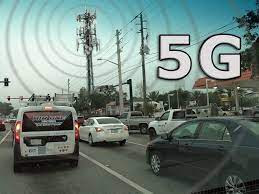5G Technology
Introduction: -
The previous generations of mobile networks are 1G, 2G, 3G,
and 4G. as the time passed, need of high-speed
internet increases which current 4G cannot fulfil which led to rise of 5G which
is designed to provide more connectivity than was ever available before.
With high speeds, superior responsibleness and negligible latency, 5G can expand the mobile scheme into new realms. 5G will impact every industry, making safer transportation, remote healthcare, precision agriculture, digitized logistics and more a reality. This network improvement will have far-reaching impact on how people live, work and play all over the world. Let’s see what specifically 5G is!
What is 5G?
5G is the 5th generation mobile network. It is a
new global wireless standard after 1G, 2G, 3G, and 4G networks. 5G enables a
new kind of network that is designed to connect virtually everyone and
everything together including machines, objects, and devices.
5G
wireless technology is meant to deliver higher multi-Gbps peak data
speeds, ultra
low latency, more
reliability, massive network capacity, increased availability, and a more
uniform user experience to more users. Higher performance and improved
efficiency empower new user experiences and connects new industries.
Who
invented 5G?
No one company or person
owns 5G, but there are several companies within the mobile ecosystem that are
contributing to bringing 5G to life. In India companies like jio, airtel and Vi
are trying to bring 5G in India.
We are at the heart of
the 3rd Generation Partnership Project (3GPP), the industry organization that defines the global
specifications for 3G UMTS (including HSPA), 4G LTE, and 5G technologies.
Other 3GPP 5G members range
from infrastructure vendors and component/device manufacturers to mobile
network operators and vertical service providers.
How is 5G better than 4G?
For starters, think of 5G as not the natural evolution of 4G but a new,
more advanced technology itself.
While earlier generations used cell towers to transmit signals, 5G will
use small cell technology. This means that carriers will deploy high band 5G
small cells in multiple locations. Additionally, as part of its OFDM coding, 5G
technology is built to use 100 to 800 MHz channels instead of 4G’s 20 MHz.
Remember, the higher the channels, the more the download speed. Thus, 5G is 20
times faster than the previous generation, has much lower latency and
tremendously improved reliability.
|
4G |
5G |
|
|
Bandwidth |
200mbps |
1gbps |
|
Download Speed |
1gbps |
10gbps |
|
Latency |
60-90ms |
1ms |
|
Base Station |
Cell towers |
|
|
OFDM Coding |
20MHZ channels |
100-800 MHZ channels |
Where is 5G being used in Industry & its Applications?
Here are some of Applications of 5G in our day-to-day life and
industries:
1. Smart cities and smart buildings:- With IoT (Internet of Things) sensors having the ability to observe and collect knowledge on air quality, energy usage, traffic patterns for cities, civic authorities are going to be ready to manoeuvre operations effectively. Emergency vehicles can hook up with destinations unrestrained, Smart buildings can have disruption-free basic amenities and connected buildings can create remote operating the norm!
2.
Manufacturing sector: Artificial intelligence will
analyse vast volumes of data being collected in order to automate human
procedures such as quality control, standardisation, precision checking, and so
on. Fully automated devices will make risky and hard work for humans done by
robots easily.
3.
Healthcare & telemedicine: Remote diagnosis and
surgeries will become common, while medical device implants will capture and
transmit health data to specialists with ease, making early detection of
diseases possible.
4.
The automobile sector, transportation: Self-driving
vehicles that can communicate in real-time with other nearby vehicles and fixed
roadway infrastructures will be possible.
5.
Virtual reality, entertainment, live event experiences: Virtual
Reality will become more viable, enabling remote working from global locations,
or an authentic live sports stadium experience at home. Virtual shopping in different
cities of the world will emerge while downloading offline entertainment will be
redundant.
Where 5G Technology Has Been Deployed?
5G is hitting the mainstream fast According to a GSA report, 58 countries had 5G networks as of June 2021, up from 38 about a year ago. A dozen more have had 5G mobile technology deployed in part. It is in fact expected that 5G will reach 1 billion users in 3.5 years, compared with 4 years for 4G and 12 years for 3G.
The Americas and Europe are on the forefront of 5G implementation, as our map shows. But investments in the
technology have also been made in almost every country in Asia.
South Korea is the country which
deployed the first 5G network and is expected to stay in the lead as far as
penetration of the technology goes, By 2025, almost 60 percent of mobile subscriptions in South Korea are expected to be for 5G networks.
Credits and references: Pratham Anmulwar (SY Meta) , Team Tech tuesday
Hyperlinks are active.
Image ref: https://www.publicdomainpictures.net/en/view-image.php?image=291931&picture=5g-tower&__cf_chl_f_tk=iiItkmECCAMRr3ouFX7aoZR1K1k9MEgYbFGbfzqm8TM-1642468718-0-gaNycGzNCxE
https://images.app.goo.gl/3x4X3zJy6GA16ptm6
NOTE:-
This blog is meant for Educational Purpose only .We do not own any Copyrights related to images and information , all the rights goes to their respective owners . The sole purpose of this blog is to Educate, Inspire, Empower and to create awareness in the viewers. The usage is non-commercial(Not For Profit) and we do not make any money from it.
FOLLOW US ON:-
INSTAGRAM :
LINKEDIN:
YOUTUBE:-






Comments
Post a Comment